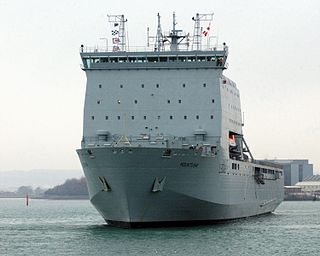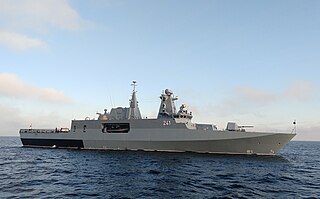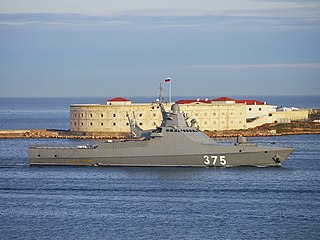
The Oscar class, Soviet designations Project 949 Granit and Project 949A Antey, are a series of nuclear-powered cruise missile submarines designed in the Soviet Union for the Soviet Navy. First built in the 1970s, six remain in service with the Russian Navy. Two other vessels were slated to be modernized since at least 2017 as Project 949AM, to extend their service life and increase combat capabilities but it is unclear whether work continues as of 2023.

The Kirov class, Soviet designation Project 1144 Orlan, is a class of nuclear-powered guided-missile cruisers of the Soviet Navy and Russian Navy, the largest and heaviest surface combatant warships in operation in the world. Among modern warships, they are second in size only to large aircraft carriers, and of similar size to a World War I-era battleship. The ships are often referred to as battlecruisers by Western defence commentators due to their size and general appearance. The Soviet classification of the ship-type is "heavy nuclear-powered guided-missile cruiser".

The Russian Navy is the naval arm of the Russian Armed Forces. It has existed in various forms since 1696; its present iteration was formed in January 1992 when it succeeded the Navy of the Commonwealth of Independent States.

The Akula class, Soviet designation Project 971 Shchuka-B are a series of fourth generation nuclear-powered attack submarines (SSNs) first deployed by the Soviet Navy in 1986. There are four sub-classes or flights of Shchuka-B, consisting of the original seven Project 971 boats, commissioned between 1984 and 1990; six Project 971Is, commissioned between 1991 and 2009; one Project 971U, commissioned in 1995; and one Project 971M, commissioned in 2001. The Russians call all of the submarines Shchuka-B, regardless of modifications.

The Bay class is a ship class of four dock landing ships built for the British Royal Fleet Auxiliary (RFA) during the 2000s. They are based on the Dutch-Spanish Royal Schelde Enforcer design, and replaced the Round Table-class logistics ships. Two ships each were ordered from Swan Hunter and BAE Systems Naval Ships. Construction work started in 2002, but saw major delays and cost overruns, particularly at Swan Hunter's shipyard. In mid-2006, Swan Hunter was stripped of work, and the incomplete second ship was towed to BAE's shipyard for completion. All four ships, Largs Bay, Lyme Bay, Mounts Bay, and Cardigan Bay had entered service by 2007.

The Black Sea Fleet is the fleet of the Russian Navy in the Black Sea, the Sea of Azov and the Mediterranean Sea. The Black Sea Fleet, along with other Russian ground and air forces on the Crimean Peninsula, are subordinate to the Southern Military District of the Russian Armed Forces.

The Krivak class, Soviet designation Project 1135 Burevestnik, are a series of frigates and guard ships built in the Soviet Union primarily for the Soviet Navy since 1970. Later some sub-branches, like the Nerey (Nereus) were designed for coastal patrol by the KGB Border Troops. Until 1977, the ships in the class were considered to be large anti-submarine warfare vessels.
The Royal Australian Navy, although a significant force in the Asia-Pacific region, is nonetheless classed as a medium-sized navy. Its fleet is based around two main types of surface combatant, with limited global deployment and air power capability. However, in 2009, a white paper, Defending Australia in the Asia Pacific Century: Force 2030, was produced by the Australian government which set out a programme of defence spending that will see significant improvements to the RAN's fleet and capabilities.

The Neustrashimy class, Soviet designation Project 11540 Yastreb (hawk), is a series of large frigates built for the Soviet Navy and currently in service with the Russian Navy. Seven ships were planned for the Soviet Navy, but the fall of the Soviet Union disrupted those plans. Two ships were completed, both currently in active service with the Russian Baltic Fleet.

The Zubr class, Soviet designation Project 1232.2, is a class of Soviet-designed air-cushioned landing craft (LCAC). The name "Zubr" is Russian for the European bison. This class of military hovercraft is, as of 2023 the world's largest hovercraft, with a standard full load displacement of 555 tons. The hovercraft was designed to sealift amphibious assault units from equipped/non-equipped vessels to non-equipped shores, as well as to transport and plant naval mines.

Novík was a destroyer of the Russian Imperial Navy and Soviet Navy, commissioned in 1913 where she served with the Baltic Fleet during World War I. She joined the Bolsheviks in November 1917 and was renamed Yakov Sverdlov in 1923. She was a training ship when Operation Barbarossa began, but was recalled to active duty the following day. She struck a mine on 28 August 1941 and sank while escorting an evacuation convoy during the Soviet evacuation of Tallinn.

The Pauk class is the NATO reporting name for a class of small patrol corvettes built for the Soviet Navy and export customers between 1977 and 1989. The Russian designation is Project 1241.2 Molniya-2. These ships are designed for coastal patrol and inshore anti-submarine warfare. The design is the patrol version of the Tarantul class which is designated Project 1241.1, but is slightly longer and has diesel engines. The ships are fitted with a dipping sonar which is also used in Soviet helicopters.

The Gawron class or Projekt 621 was a planned class of multipurpose corvettes ordered by Polish Navy. The Gawron class was a variant of the MEKO A-100 project developed by the Blohm + Voss shipyard in Germany. Construction of the first ship of the class started in 2001. The project was terminated in February 2012 but in October 2013 a contract was signed to complete the existing hull as a patrol ship by 2016. On 2 July 2015, ORP Ślązak was christened and launched, and on 28 November 2019, ORP Ślązak was officially commissioned into the Polish Navy.

The Admiral Gorshkov class is a class of frigates of the Russian Navy. The ships are being built by the Severnaya Verf in Saint Petersburg at a cost of $250 million per ship. The class, designated by Russia as Project 22350, was designed by the Severnoye Design Bureau and incorporates use of stealth technology. As of August 2020, ten vessels have been ordered for delivery by 2027. The lead ship of the class, Admiral Gorshkov, was commissioned on 28 July 2018.

Ukraina is a Ukrainian Slava-class cruiser originally ordered by the Soviet Union in the early 1980s under the name Admiral Flota Lobov. After the Soviet Union disbanded in the early 1990s, the ship passed on to Russia and then to Ukraine, assuming the name Ukraina. In 2010 the Ukrainian parliament stripped the ship of its name. The ship remains unfinished and is currently moored at the Mykolayiv Shipyard.

The Admiral Grigorovich-class, also referred to as Krivak V class, Russian designation Project 11356R, is a class of frigates built by the Yantar Shipyard in Kaliningrad for the Russian Navy and Indian Navy, with a cost of $450-500 million. Based on the Talwar class, six ships were ordered for the Russian Black Sea Fleet under two contracts in 2010 and 2011 as a complement to the Admiral Gorshkov-class frigates.

The Pacific Fleet is the Russian Navy fleet in the Pacific Ocean.
Following the dissolution of the Soviet Union at the end of 1991, the Russian Navy struggled to adjust Cold War force structures while suffering severely with insufficient maintenance and a lack of funding. However, improvements in the Russian economy over the first decade of the twenty-first century led to a significant rise in defence expenditure and an increase in the number of ships under construction.

Project 22160 is a series of large patrol ships being constructed for the Russian Navy. The vessels are primarily intended for duties such as patrol, monitoring and protection in open and closed seas. The first ship was laid down in February 2014 and joined the Russian Navy in December 2018. By January 2018, six ships were under construction.

Oryol is a Project 11351 Nerey-class frigate of the Coast Guard of the Federal Security Service of Russia. Previously the ship served in the KGB Border Troops Naval Service as Imeni XXVII siezda KPSS.

















